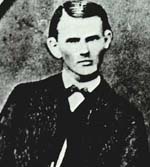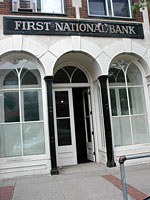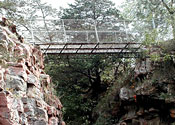Following the trail of Jesse James
By Mark Steil
Minnesota Public Radio
September 7, 2001
What may be the most famous crime in Minnesota history occured 125 years ago - September 7, 1876. The robbery at the First National Bank of Northfield had famous outlaws like Jesse James and Cole Younger, and heroes like bank bookkeeper Joseph Lee Heywood. The details of the robbery itself are well known and will be re-enacted this weekend in Northfield as part of the annual "Defeat of Jesse James Days." Less well-known are the events that came after the robbery attempt, as the gang fled across southern Minnesota, pursued by a host of posses.
WHEN THE JAMES-YOUNGER GANG RODE INTO NORTHFIELD
that afternoon, they were the nation's best-known criminal gang - and they acted the role. Riding the best horses, packing the best guns and decked out in new linen cowboy dusters, they had no idea robbing the Northfield bank would be the gang's last job. The outlaws had already pulled off a series of railroad and bank heists across the Midwest and South, but Northfield was a far different experience. Here the residents shot back. Quickly, two outlaws lay dead along with bank bookkeeper Joseph Lee Heywood, who refused to open the safe. A second Northfield resident would die several days later from a gunshot wound. The gang members scooped up their injured and galloped out of town.
One of the dead outlaws was long-time Minnesota resident Bill Stiles, also known as Bill Chadwell - the gang member who best knew the roads, rivers and railways of the state. Rex Macbeth of North Mankato has spent a lifetime studying the Northfield robbery. He believes Stiles influenced the gang's decision to come to Minnesota.
"The feeling is that he told the guys 'Let's go to Minnesota. Banks are full of money, bunch of dumb farmers up there, don't have any saddle horses, they can't shoot, won't have no trouble at all. We can get their money and get out of there easy,'" says Macbeth.
Frank and Jesse James; Cole, Bob and Jim Younger; and Charlie Pitts rode southwest through a string of small Minnesota towns. Dundas, Millersburg, Shieldsville, Morristown, Kilkenny, Elysian. Several times the gang exchanged shots with pursuing posses. Near Elysian, the gang decided to abandon their horses and walk. The animals were worn out and the outlaws thought they could hide out better on foot.
"Every farmer and everybody around that had anything that would go off thought they were going to go out and get a reward," says Macbeth. "So the woods were full of people, some hollering in Norwegain, some in German, some in English. Stomping and crashing through the brush and hollering at each other. They made so much noise that the boys could just sneak along and hear the posses moving about. It wasn't too hard to hide from the posses," says Macbeth.
As they clawed their way through dense underbrush, the fleeing gang was a far sight from the cowboy dandies who'd arrived in Minnesota by train a month earlier. Before striking Northfield, they spent time in the Twin Cities, gambling and buying supplies. They also scouted southern Minnesota towns like St. Peter, Mankato, Madelia and Red Wing. When the Northfield raid went bust, the gang was far from its home territory where it could count on Southern sympathizers to hide them. Newspapers called the Northfield robbery the state's biggest event since the Dakota Indian War of 1862. When it appeared the gang would escape, the editor of the Worthington newspaper huffed about the state's role.
"An undisciplined mob of men and boys have been in pursuit, with here and there a sheriff or policeman with a band of two or three disciplined men. If Gov. Pillsbury had at once called on the sheriff of every county to organize a posse of picked men and then placed them all under one head, the robbers might have been taken," the editor wrote.
As the gang headed west on foot from Elysian, their plan seemed to work. They were rarely spotted and the posses grew fewer. But near Mankato, a farmhand out looking for cows stumbled on the gang hiding in the woods. The outlaws debated whether to kill him, finally deciding to let him go after the man promised not to tell. But he told anyway, and hundreds of re-invigorated searchers took to the roads. Still, the gang managed to press ahead. They slipped through Mankato at midnight. Morning found them about four miles west of Mankato in what is now Minneopa State Park. Rex Macbeth points out a heavily wooded area where he believes the last camp of the James-Younger gang was located.
"We've often been asked why they picked this place. And I don't think it was so much a matter of picking the place as simply exhaustion. They kept going until they just couldn't stagger anymore, and they collapsed and spent the night," he says.
Macbeth says here the outlaws decided to part company, forever as it turned out. Jesse and Frank James stole some horses and headed south together. The Younger brothers and Charlie Pitts continued west on foot, escaping just as a posse closed in on their Minneopa camp.
After leaving Minneopa, the Younger faction was not seen for a week, but that changed on September 21. Del Begalka's great-grandfather, Thomas Vought, owned a hotel then in Madelia, 20 miles southwest of Mankato. Vought and the local sheriff were standing on the hotel's veranda that day when a farm boy galloped into town.
"A Norwegian young man, 17 years old, Oscar Sorbel, came to town and indicated to them standing on the verenda that he was sure he'd seen the Younger brothers," says Begalka.
A posse spotted the gang as it made its way through the swamps and high grass of the Watonwan River bottoms. At times the posse got close enough to fire. One shot snapped Cole Younger's walking stick. But every time the posse closed in, the outlaws escaped by wading through swamps impassable to horses. The end of the chase came just south of the town of La Salle, where the posse cornered the gang.
"At Sheriff Glispin's command they proceeded toward where the outlaws were. Sheriff Glispin gave the order that when they see the smoke from the pistols, they should fire where that was coming from," says Begalka.
In the flurry of gunshots, gang member Charlie Pitts was killed, and the three Younger brothers were captured by the posse.
Western history buff Rex Macbeth remembers the shootout in a poem called Ode to Charlie Pitts.
from the state on horseback, traveling through southwest Minnesota. There were many reported sightings of the two, but no one is sure how many are true. Burton Burkman, 80, of Brandon, S.D. has a Jesse James story which is still told in the family.
"Uncle Andrew said if they come, he had his own musket there. He said he'd fix 'em - they wouldn't take anything there. Boy, it wasn't long before Frank and Jesse came in. And they took the saddles off their horses, and saddled up his horses and took off," says Burkman.
But the most mythic Jesse James story is found in eastern South Dakota near the town of Garretson. A 20-foot long foot bridge spans a 30-foot deep gorge. The spot is known as Devil's Gulch. The story is that Jesse James leaped the gulch on horseback as a posse closed in. Most historians doubt it happened, saying the span is too great.
But even if the physical leap did not occur here, a physic leap did. Though Jesse James got the daylights beat out of him in Northfield, in the land of legend he is never defeated. The outlaw who bungled a bank robbery in a small Minnesota town is resurrected by a miraculous jump. It's folk stories like this which freed Jesse James from the shackles of reality, and propelled him into the heart of American mythology.
More Information
Defeat of Jesse James Days in Northfield
Northfield Historical Society
By Mark Steil
Minnesota Public Radio
September 7, 2001
|
|
RealAudio |
What may be the most famous crime in Minnesota history occured 125 years ago - September 7, 1876. The robbery at the First National Bank of Northfield had famous outlaws like Jesse James and Cole Younger, and heroes like bank bookkeeper Joseph Lee Heywood. The details of the robbery itself are well known and will be re-enacted this weekend in Northfield as part of the annual "Defeat of Jesse James Days." Less well-known are the events that came after the robbery attempt, as the gang fled across southern Minnesota, pursued by a host of posses.
| |
|
|
|
||
One of the dead outlaws was long-time Minnesota resident Bill Stiles, also known as Bill Chadwell - the gang member who best knew the roads, rivers and railways of the state. Rex Macbeth of North Mankato has spent a lifetime studying the Northfield robbery. He believes Stiles influenced the gang's decision to come to Minnesota.
"The feeling is that he told the guys 'Let's go to Minnesota. Banks are full of money, bunch of dumb farmers up there, don't have any saddle horses, they can't shoot, won't have no trouble at all. We can get their money and get out of there easy,'" says Macbeth.
Frank and Jesse James; Cole, Bob and Jim Younger; and Charlie Pitts rode southwest through a string of small Minnesota towns. Dundas, Millersburg, Shieldsville, Morristown, Kilkenny, Elysian. Several times the gang exchanged shots with pursuing posses. Near Elysian, the gang decided to abandon their horses and walk. The animals were worn out and the outlaws thought they could hide out better on foot.
| |
||
|
||
| |
||
As they clawed their way through dense underbrush, the fleeing gang was a far sight from the cowboy dandies who'd arrived in Minnesota by train a month earlier. Before striking Northfield, they spent time in the Twin Cities, gambling and buying supplies. They also scouted southern Minnesota towns like St. Peter, Mankato, Madelia and Red Wing. When the Northfield raid went bust, the gang was far from its home territory where it could count on Southern sympathizers to hide them. Newspapers called the Northfield robbery the state's biggest event since the Dakota Indian War of 1862. When it appeared the gang would escape, the editor of the Worthington newspaper huffed about the state's role.
"An undisciplined mob of men and boys have been in pursuit, with here and there a sheriff or policeman with a band of two or three disciplined men. If Gov. Pillsbury had at once called on the sheriff of every county to organize a posse of picked men and then placed them all under one head, the robbers might have been taken," the editor wrote.
As the gang headed west on foot from Elysian, their plan seemed to work. They were rarely spotted and the posses grew fewer. But near Mankato, a farmhand out looking for cows stumbled on the gang hiding in the woods. The outlaws debated whether to kill him, finally deciding to let him go after the man promised not to tell. But he told anyway, and hundreds of re-invigorated searchers took to the roads. Still, the gang managed to press ahead. They slipped through Mankato at midnight. Morning found them about four miles west of Mankato in what is now Minneopa State Park. Rex Macbeth points out a heavily wooded area where he believes the last camp of the James-Younger gang was located.
| |
|
|
|
||
Macbeth says here the outlaws decided to part company, forever as it turned out. Jesse and Frank James stole some horses and headed south together. The Younger brothers and Charlie Pitts continued west on foot, escaping just as a posse closed in on their Minneopa camp.
After leaving Minneopa, the Younger faction was not seen for a week, but that changed on September 21. Del Begalka's great-grandfather, Thomas Vought, owned a hotel then in Madelia, 20 miles southwest of Mankato. Vought and the local sheriff were standing on the hotel's veranda that day when a farm boy galloped into town.
"A Norwegian young man, 17 years old, Oscar Sorbel, came to town and indicated to them standing on the verenda that he was sure he'd seen the Younger brothers," says Begalka.
A posse spotted the gang as it made its way through the swamps and high grass of the Watonwan River bottoms. At times the posse got close enough to fire. One shot snapped Cole Younger's walking stick. But every time the posse closed in, the outlaws escaped by wading through swamps impassable to horses. The end of the chase came just south of the town of La Salle, where the posse cornered the gang.
"At Sheriff Glispin's command they proceeded toward where the outlaws were. Sheriff Glispin gave the order that when they see the smoke from the pistols, they should fire where that was coming from," says Begalka.
In the flurry of gunshots, gang member Charlie Pitts was killed, and the three Younger brothers were captured by the posse.
Western history buff Rex Macbeth remembers the shootout in a poem called Ode to Charlie Pitts.
"For 14 days they fought their way, hungry, wet and coldWhile the capture of the Youngers brought an end to part of the saga, the story of Frank and Jesse James is less certain. After splitting from the Youngers in Minneopa, the two made a quick exit
Til on September 21st Pitts' final tale was told
He stayed true to his friends to the very end
And they knew that's what he'd do
And it took five hits to kill Charlie Pitts,
down in Hanska Slough."
| |
|
|
|
||
"Uncle Andrew said if they come, he had his own musket there. He said he'd fix 'em - they wouldn't take anything there. Boy, it wasn't long before Frank and Jesse came in. And they took the saddles off their horses, and saddled up his horses and took off," says Burkman.
But the most mythic Jesse James story is found in eastern South Dakota near the town of Garretson. A 20-foot long foot bridge spans a 30-foot deep gorge. The spot is known as Devil's Gulch. The story is that Jesse James leaped the gulch on horseback as a posse closed in. Most historians doubt it happened, saying the span is too great.
But even if the physical leap did not occur here, a physic leap did. Though Jesse James got the daylights beat out of him in Northfield, in the land of legend he is never defeated. The outlaw who bungled a bank robbery in a small Minnesota town is resurrected by a miraculous jump. It's folk stories like this which freed Jesse James from the shackles of reality, and propelled him into the heart of American mythology.
More Information




